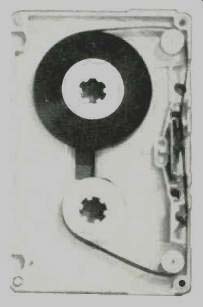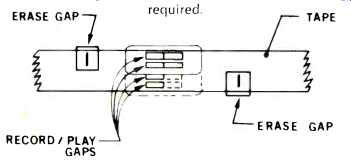by Don Humphreys [ Michigan Magnetics, Vermontville, Mich.]
For several years now the eight track-cartridge supporters and the cassette supporters have been playing down the existence of a conflict over which system will become the victor and which will be the vanquished in the consumer marketplace. Some observers feel that there will be no decisive winner, that each system will find its own niche, and that the two systems will co-exist as in the case of the 45-rpm disc versus the 33 1/3-rpm disc. They further feel that this peaceful state of co-existence will also find room to tolerate the open reel-to-reel market, the four-track cartridge system, and even the Play tape system. Other observers feel that one of the two (either eight-track or cassette) will bury all the other systems.

Fig. 1--Cutaway view of 8-track endless loop cartridge.
As a neutral observer, we have noticed how each industry has been striving to add the features of the opponent's system to its own system. For instance: when the original battle lines were formed, eight-track featured: (1) Playback only; (2) Continuous play; (3) Rapid one direction selection of four programs; (4) A formidable library of prerecorded music from the top-of-the line duplicator (record) giants. In contrast, cassettes featured: (1) Record/playback capabilities. (2) Fast forward and reverse search capabilities. (3) A more compact tape package.
The cassette people subsequently introduced: (1) Playback-only models to appease the recording/artists/copyright faction; (2) Continuous-loop winds in cassette cartridges; (3) Excellent libraries of pre-recorded tape releases to satisfy the dealers' requests for a continuing after market.
The eight-track people, not to be outdone, countered with: (1) Record/ play models, (2) Smaller packages that matched the cassette in two dimensions (now they would only be thicker to accommodate the ¼” tape instead of the 0.150 tape).

Fig. 2--Cutaway view of enclosed reel-to-reel cassette.

Fig. 3--Standard cassette openings are illustrated here. See text for
references.

Fig. 4--For effective recording in a reversing cassette system, six
gap positions are required.
The "Match Features" contest intensified as both systems displayed radios packaged into their cartridges that effectively converted the tape players into FM and AM receivers and the Audio Component people began showing the systems packaged with tuners, record changers, and portable transistor radios. One enterprising manufacturer even showed an eight track cartridge that would accept and play a cassette.
Somewhere in the middle of all this, a "Starr-System" modification of the basic cassette system was introduced; and stack loaders and slot loaders were introduced by Phillips and several others. Shortly thereafter a company named Quatron entered the fray by introducing a carousel-type, eight track unit that approximates the new stack-loader features of the opponent.
If you now compare the two systems, you can see that each industry has almost matched the other, feature for feature. Nevertheless, there still remained two salient differences:
(1) Eight-track could not reverse or search (although several manufacturers are now promising this feature soon).
(2) The continuous-loop cassette was not considered a bona fide solution to the continuous-play requirement.
For better than a year now, many cassette manufacturers have been promising automatic reversing machines to solve the continuous-play dilemma. In fact, at the last CES show in New York (June), Craig showed a playback-only version of an automatic reverse unit; and Roberts showed a prototype of a unit that reached into the cassette, pulled out a loop of tape, and accomplished the bi-directional feat.
The record feature of the eight track worked well, but potential users were frustrated in their recording attempts by the inability to reverse or pause conveniently during the recording process to eliminate commercials or to record over a selection no longer wanted on this program.
Eight-track remained the best continuous-playback medium, and cassette remained the best recording system.
A patent recently issued to Michigan Magnetics, and other patent applications in process, have now added the next chapter in the unfolding drama. The Michigan Magnetics "K Set System" utilizes a shifting cassette head (similar to eight-track) that provides a solution to achieving a bidirectional cassette with full record and playback features.
The problem was a tricky one. As can be seen in Fig. 3, the standard cassette has only five openings. Openings A and E are taken up (in an automatic reversing deck) by pinch rollers, since one roller is needed for forward tape motion and another needed for reverse. For best time-base stability, the capstan and pinch roller should be downstream of the tape head to ensure adequate tape wrap and a pulling movement of tape instead of a pushing movement.
Openings B and D have no pressure pads behind the tape, so using a head in these holes was considered impractical.
This leaves only opening C to accommodate three heads! Worse yet, the pressure pad in most cassettes is only 1/8" long. To use a four-channel combination head would require six gaps on a pad measuring 1/8" by 3/16". To date no one has been able to mass produce such a design. Note that a four-channel head would be needed to provide stereo pairs in both directions. This means up to six coils in a tiny head, with each coil acting on the others in a transformer fashion so that a signal in one would induce crosstalk in the others. A further complication arises when four channels replace two. In this instance, all coils must have less turns to make room for each other; and less turns mean less output. As the output of a head decreases, the signal-to-noise ratio of the system must suffer. If you are not yet impressed with the complicated nature of the beast, let me now add that a record/play head without an erase head upstream is almost useless.
For effective recording technique, a system would have to have the six gaps positioned as shown in Fig. 4.
The Michigan Magnetics "K-Set System" proposes to solve the problem by using the proven eight-track shifting technique. Erase heads are inserted in openings B and D to erase the tape immediately before recording in either the forward- or reverse-drive direction. As indicated earlier, this would not be an ideal place to erase because there are no pressure pads behind the tape for good tape-to-head contact. Still true, but the difference is that this system uses a newly developed ferrite erase head that will take high-frequency (70 kHz) erase currents of sufficient amplitude to "bloom" well beyond the gap and erase previously saturated tape to a remarkably low level of -60 dB. The outboard erase heads have built-in precision tape guides that replace the fork type common on many heads.
Now we get into the heart of the system. Michigan Magnetics has announced that the shifting head (that will operate in opening C of Fig. 3 will have the same electrical specifications as its standard "K-Set" stereo head. This means no sacrifices in the 1-kHz sensitivity, or in the 1 to 10 kHz frequency-response ratio, or in the crosstalk specs. Perhaps even more important, it means a program-1-to program-2 crosstalk level that is almost non-existent. One of the problems that confronted engineers considering the four-channel-head approach was the fact that every time the tape changed direction, the critical audiophile user would have to jump up and readjust his balance control since a new pair of head channels would be used. The Michigan Magnetics "K-Set System" obviously eliminates this problem, since only one pair of channels is used; and, once the balance is adjusted for one direction of tape travel, channel balance is the same in the opposite direction.
It will be interesting to see how the industry will accept the drop-in feature of the system.
==========
(adapted from Audio magazine, Jan. 1970)
Also see:
High Fidelity from Cassette Systems (Oct. 1973)
Cassette Tape Recording Bias (Nov. 1973)
Dolby B-Type Noise Reduction System (Sept. 1973)
Cassettes and the Dolby System (May 1970)
= = = =